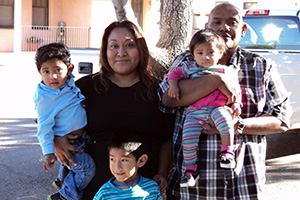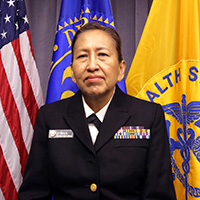On the afternoon of August 14, 2016, Ms. Ramon and Mr. Holloway were driving with their two young children to the store and their vehicle was struck at a traffic light where their car sustained significant damage after being side swiped by cross traffic. Both of the back tires were blown out, the axle was broken and the driver’s side doors were heavily damaged. Luckily, the children were secure in properly fitted and installed car seats. At the crash scene, their son was able to walk and jump around and their daughter was able to move freely as well. First responders reported the parents did a great job installing the car seats, making the parents feel proud, fortunate and extremely grateful.
Grateful for the services of Feliciano Cruz, Jr., a public health emergency preparedness and injury prevention coordinator with the Pascua Yaqui Tribe , who had conducted a child passenger safety class attended by the parents and assisted the family to ensure everyone rides safe while in the car. The parents remarked that his instruction was very detailed and his advice stuck with them.

On October 11, IHS released the report, Indian Health Focus: Injuries 2015 Edition cataloging American Indian and Alaska Native-specific injury data. Injuries are the leading cause of death among American Indians and Alaska Natives between the ages of one and 44 years; especially among children. Unintentional injury deaths for American Indians and Alaska Natives decreased by 58 percent (1973-2008). Injuries cost IHS, tribes and Purchased/Referred Care (PRC) approximately $350 million per year in the treatment of injuries and accounts for 44 percent of the years of potential life lost before age 65 for American Indian and Alaska Native populations.
The IHS Injury Prevention Program is the lead IHS program to address the injury disparities in American Indian and Alaska Native communities. Top program priorities include motor vehicle and unintentional elder fall prevention. The program’s approach is based on the same public health principles that have been applied to effectively control infectious diseases. Using the public health approach and focusing on the implementation of evidence-based injury prevention strategies can have significant public health impact and the program supports community-specific solutions.
The Pascua Yaqui Tribe of Arizona continues to build upon the IHS Injury Prevention funding they received ($50,000 annually, 2000-2005). Mr. Cruz, a member of the Pascua Yaqui Tribe, served as a former member of the IHS Injury Prevention Tribal Steering Committee member from 2004 to 2008 and has been a certified Child Passenger Safety Technician since 2000. The Pascua Yaqui Tribe was awarded funds from the IHS TIPCAP ($20,000 annually, 2015-2020) to expand their reach of injury prevention activities.
IHS’s collaborative partnership with the Tribe is one way we are proud to raise the health status of the Ramon/Holloway family and have them be able to spend another day as a family.
Read more about this program.
CAPT Nancy M. Bill, a member of the Navajo Nation, oversees the 12 national IHS regions serving the 567 federally recognized American Indian and Alaska Native tribes to ensure consultation, collaboration and partnership in injury prevention.



